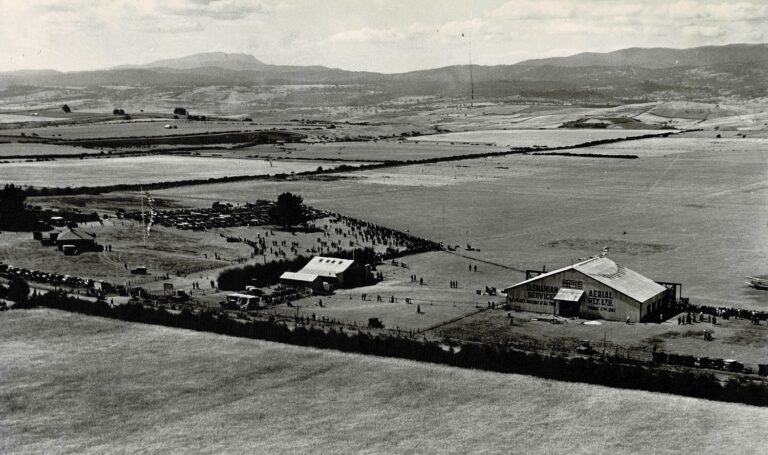With the opening of Tasmania’s first licensed Aerodrome at Western Junction (Launceston) in 1931, Charles Kingsford Smith would fly the first passenger service from Essendon. The direct air link with Victoria was established.

1930
Aero Club and Western Junction Aerodrome
Captain Joseph Francis flew the first plane off the newly completed Western Junction aerodrome on 23 November 1930. It was the Gipsy Moth, VH-ULM, of the Australian Aero Club (Tasmanian Section).
A group of Launceston aviation enthusiasts formed the Aero Club in October 1927, (later renamed the Tasmanian Aero Club, which still operates today). Their goal was to establish an aerodrome at Launceston and undertake pilot training.
The Aero Club and Civil Aviation selected the site at Western Junction just south of Launceston city. The Commonwealth Civil Aviation Branch purchased land in 1929 from the Hogarth families and developed Tasmania’s first licenced aerodrome a year later.
The Federal Government, through Civil Aviation, offered a pilot training subsidy, as well as training planes, to the Aero Club
By late 1930, everything was ready with the Aero Club receiving two Gipsy Moth biplanes, registrations VH-ULM and VH-ULN. The Aero Club contracted Matthews Aviation to undertake the pilot training and maintain the planes. Captain Joseph Francis was the instructor and Lawrence Johnson his assistant.
The Aerodrome was officially opened on 28 February 1931 when an Air Pageant was held. 15,000 people (over 10% of the Tasmanian population) attended.
It is now known as Launceston Airport.
![Kingsford Smith (centre in leather coat) and passengers of first A.N.A flight to Western Junction, January 1931 [Weekly Courier]](https://bassstraitflight.au/wp-content/uploads/2022/11/Start-2-1024x654.jpg)
![Charles Kingsford Smith, after inaugurating A.N.A. Passenger Service to Western Junction, January 1931 [Weekly Courier]](https://bassstraitflight.au/wp-content/uploads/2022/11/Start-3.jpg)
1931
First Bass Strait Passenger Flights – Australian National Airways
Piloted by Charles Kingsford Smith, the Southern Cloud, VH-UMF, carried 10 commercial passengers from Melbourne to Launceston on 16 January 1931.
Charles Kingsford Smith and Charles Ulm became Australian icons in 1928 when they were the first to fly across the Pacific Ocean, from California to Brisbane, in the Southern Cross. Completed in three sections, the flight took a total of 82 hours
They then formed Australian National Airways, (A.N.A.), one of Australia’s pioneering airlines. A.N.A. used five planes similar to the Southern Cross, that could carry ten passengers. They were named Southern Moon, Southern Sun, Southern Star, Southern Cloud and Southern Sky.
A.N.A. operated passenger flights between Brisbane, Sydney and Melbourne in 1930. The following year they extended the service to Launceston and Brighton in Tasmania. This was the first commercial passenger service across Bass Strait.
In March 1931, the Southern Cloud was lost on a flight between Sydney and Melbourne in very bad weather. An extensive search found no sign of the plane. Its wreckage was found 27 years later in the Snowy Mountains.
A.N.A. did not survive the loss of the Southern Cloud and the impact it had on public confidence in flying. A.N.A. ceased operations in June 1931, including the Tasmanian service.
In the six months A.N.A. flew to Tasmania, over 500 passengers were carried across Bass Strait. A.N.A. showed that Tasmanians wanted to fly to the mainland and would support commercial aviation.
![Australian National Airways Advertisement 1931 [Weekly Courier]](https://bassstraitflight.au/wp-content/uploads/2022/11/Start-4-773x1024.jpg)
1931
A.N.A. Flight Experience
An excerpt of a description of a flight to Tasmania published in the Hobart Mercury on 16 May 1931.
In the capacious cabin of the machine, they were directed to leather upholstered seats, five of which ranged on either side with ample view through the sliding glass panel windows. The luggage was placed in a special cabin in the tail, but a rack above the cabin seats accommodated hats and coats. In the seats were morning papers. The passengers stuffed their ears with cotton wool and ate two Minties. Both of these articles had been supplied to them in a little paper bag; the cotton wool to reduce the drone of the engines, and the Minties to prevent air sickness in the remote case of which waterproof paper bags were within easy reach for that purpose. After use it was requested that the bag be thrown out of the window!
From the moment the air liner roared into the wind and the ground fell away, the ears of this young man were alert for the slightest falter in one of the engines, the drone of whose propellers reached him in waves. It did not come. The incessant drone reassured him.
With Melbourne fading in the morning mist the huge Fokker droned over a patchwork countryside of fresh green daubed with red roots. It followed a coast where the surf was breaking white.
The liner hugged the Flinders group and islands passed like phantom shapes enshrouded in gossamer veils. Passing the tortuous course of the Tamar like a wriggling sliver whip on the right the air liner was allowed to fall into a delicious glide, and the ground at Western Junction aerodrome brought imaginative passengers back to mundane thoughts.
From Western Junction to Brighton the air liner flew over scenery which ls particularly grand from the air. Mountain ranges and the Midlands lakes compose panoramas of bold beauty. Over hill and dale, Mount Wellington loomed in the distance, and soon the great Fokker fell into a glide. After a sweet curve into the wind the earth seemed to flatten out from Its weird contortions and the liner alighted at Brighton aerodrome.
Melbourne for breakfast, Launceston for morning tea, and Hobart for lunch! The imagination runs riot to visualise the future.
